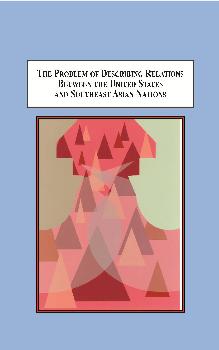Problem of Describing Relations Between the United States and Southeast Asian Nations. A Study of Political Language Games
We are currently unable to ship to the EU countries at this time. We apologize for this inconvenience.

| Author: | Misalucha, Charmaine G. | |
| Year: | 2012 | |
| Pages: | 388 | |
| ISBN: | 0-7734-2647-7 978-0-7734-2647-4 | |
| Price: | $239.95 + shipping | |
| (Click the PayPal button to buy) | ||
This book shows how political speech acts carry consequences in diplomatic relations. Focusing on interactions between the United States and Southeast Asian countries, the author shows that often the more powerful country does not get its way. American foreign policy is usually viewed as being uncompromising and hegemonic, but in reality, it strikes agreements and compromises on a regular basis.
One would assume that the wealthier, more powerful country would always get its way. This study shows that smaller countries with little or no bargaining power can benefit from relations with the United States.
One would assume that the wealthier, more powerful country would always get its way. This study shows that smaller countries with little or no bargaining power can benefit from relations with the United States.
Reviews
“If this present work is a portent of scholarship to come, the foreseeable future of the International Relations of Southeast Asia will be an intellectually vibrant and exhilarating one.”
-Prof. See Seng Tan,
Nanyang Technological University
“… argues that language games are important in explaining the influence of the US on Southeast Asian behavior, and the other way around.”
-Prof. Alan Chong,
Nanyang Technological University
“a well-written manuscript that makes an important contribution to critical International Relations theory.”
-Prof. Joseph Liow,
Nanyang Technological University
-Prof. See Seng Tan,
Nanyang Technological University
“… argues that language games are important in explaining the influence of the US on Southeast Asian behavior, and the other way around.”
-Prof. Alan Chong,
Nanyang Technological University
“a well-written manuscript that makes an important contribution to critical International Relations theory.”
-Prof. Joseph Liow,
Nanyang Technological University
Table of Contents
Abstract i
Foreword by See Seng Tan iii
Acknowledgements vi
CHAPTER 1: INTRODUCTION 1
The Argument 1
The Framework 11
Constructivism 11
The Paradigm of Rule 13
Language Games 14
Rules 16
Rule 18
Methodological Issues 24
References 28
CHAPTER 2: COUNTER-ARGUMENTS 33
Two Poles in Southeast Asia-US Relations 35
The American Role in Southeast Asia’s Politics 36
Southeast Asia’s Role in its Relations with the United States 41
International Orders and International Relations 44
Ordering International Relations 45
The “Language” of International Orders 48
Hegemony 50
Heteronomy 55
Hierarchy 62
References 67
PART I: Multilateral Platforms 79
CHAPTER 3: HEGEMONY, 1954-1977 79
Containment and Regionalism 82
Threats and Assurances 112
References 126
CHAPTER 4: HETERONOMY, 1978-1991 141
ASEAN’s Diplomatic Triumphs? 144
The US’ Key Role? 158
References 174
CHAPTER 5: HETERONOMY REDUX, 1992-2000 181
Structure 185
Crises 198
References 217
CHAPTER 6: HIERARCHY AND HEGEMONY, 2001-2010 229
Imposition 232
Negotiation and Resistance 245
References 261
PART II: Bilateral Platforms 273
CHAPTER 7: US-PHILIPPINE RELATIONS 273
Independence in the Time of the Cold War: 1946-1991 276
Uncertainty and the Post-Cold War World: 1992-2010 293
References 305
CHAPTER 8: US-INDONESIAN RELATIONS 317
Redefinition, Part I 320
Attaining Independence 320
Guided Democracy 329
New Order 335
Redefinition, Part II 342
Reformasi 342
Terrorism 344
References 348
CHAPTER 9: CONCLUSION 359
Index 367
Foreword by See Seng Tan iii
Acknowledgements vi
CHAPTER 1: INTRODUCTION 1
The Argument 1
The Framework 11
Constructivism 11
The Paradigm of Rule 13
Language Games 14
Rules 16
Rule 18
Methodological Issues 24
References 28
CHAPTER 2: COUNTER-ARGUMENTS 33
Two Poles in Southeast Asia-US Relations 35
The American Role in Southeast Asia’s Politics 36
Southeast Asia’s Role in its Relations with the United States 41
International Orders and International Relations 44
Ordering International Relations 45
The “Language” of International Orders 48
Hegemony 50
Heteronomy 55
Hierarchy 62
References 67
PART I: Multilateral Platforms 79
CHAPTER 3: HEGEMONY, 1954-1977 79
Containment and Regionalism 82
Threats and Assurances 112
References 126
CHAPTER 4: HETERONOMY, 1978-1991 141
ASEAN’s Diplomatic Triumphs? 144
The US’ Key Role? 158
References 174
CHAPTER 5: HETERONOMY REDUX, 1992-2000 181
Structure 185
Crises 198
References 217
CHAPTER 6: HIERARCHY AND HEGEMONY, 2001-2010 229
Imposition 232
Negotiation and Resistance 245
References 261
PART II: Bilateral Platforms 273
CHAPTER 7: US-PHILIPPINE RELATIONS 273
Independence in the Time of the Cold War: 1946-1991 276
Uncertainty and the Post-Cold War World: 1992-2010 293
References 305
CHAPTER 8: US-INDONESIAN RELATIONS 317
Redefinition, Part I 320
Attaining Independence 320
Guided Democracy 329
New Order 335
Redefinition, Part II 342
Reformasi 342
Terrorism 344
References 348
CHAPTER 9: CONCLUSION 359
Index 367
Other International Relations Books
1999 - Aid, Nationalism and Inter-American Relations. Guatemala, Bolivia and the United States 1945-1961
>> See all our International Relations books